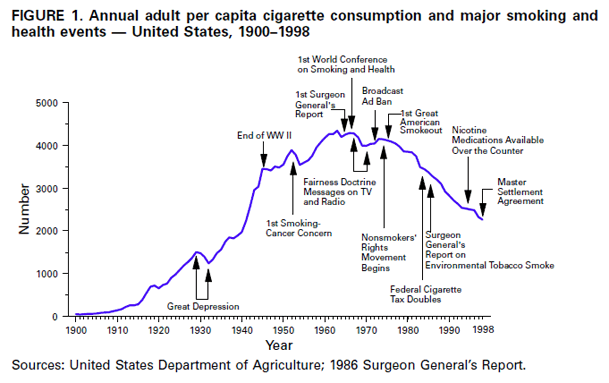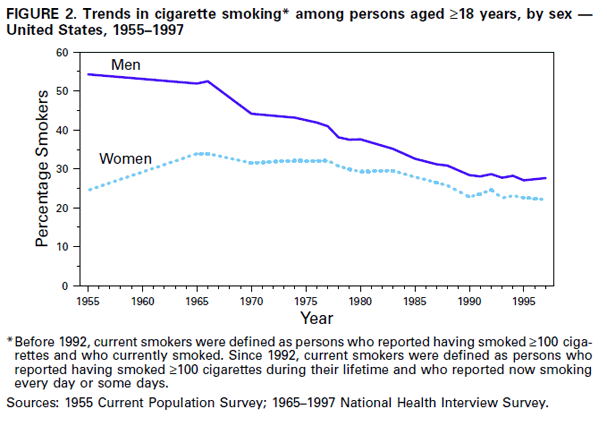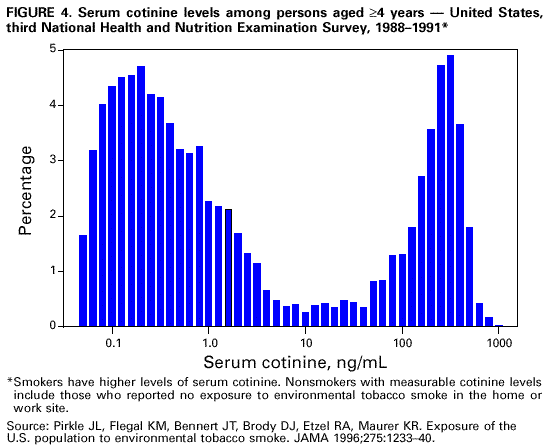 |
|
|
|
|
|
|
| ||||||||||
|
|
|
|
|
|
|
||||
| ||||||||||
|
|
|
|
|
Persons using assistive technology might not be able to fully access information in this file. For assistance, please send e-mail to: mmwrq@cdc.gov. Type 508 Accommodation and the title of the report in the subject line of e-mail. Achievements in Public Health, 1900-1999: Tobacco Use -- United States, 1900-1999An erratum has been published for this article. To view the erratum, please click here. An additional erratum has been published for this article. To view the erratum, please click here. Smoking--once a socially accepted behavior--is the leading preventable cause of death and disability in the United States. During the first decades of the 20th century, lung cancer was rare; however, as cigarette smoking became increasingly popular, first among men and later among women, the incidence of lung cancer became epidemic (Figure 1). In 1930, the lung cancer death rate for men was 4.9 per 100,000; in 1990, the rate had increased to 75.6 per 100,000 (1). Other diseases and conditions now known to be caused by tobacco use include heart disease, atherosclerotic peripheral vascular disease, laryngeal cancer, oral cancer, esophageal cancer, chronic obstructive pulmonary disease, intrauterine growth retardation, and low birthweight. During the latter part of the 20th century, the adverse health effects from exposure to environmental tobacco smoke also were documented. These include lung cancer, asthma, respiratory infections, and decreased pulmonary function (2). Large epidemiologic studies conducted by Ernst Wynder (see box) and others in the 1940s and 1950s linked cigarette smoking and lung cancer. In 1964, on the basis of approximately 7000 articles relating to smoking and disease, the Advisory Committee to the U.S. Surgeon General concluded that cigarette smoking is a cause of lung and laryngeal cancer in men, a probable cause of lung cancer in women, and the most important cause of chronic bronchitis in both sexes (3). The committee stated that "Cigarette smoking is a health hazard of sufficient importance in the United States to warrant appropriate remedial action." Substantial public health efforts to reduce the prevalence of tobacco use began shortly after the risk was described in 1964. With the subsequent decline in smoking, the incidence of smoking-related cancers (including cancers of the lung, oral cavity, and pharynx) have also declined (with the exception of lung cancer among women) (4). In addition, age-adjusted death rates per 100,000 persons (standardized to the 1940 population) for heart disease (i.e., coronary heart disease) have decreased from 307.4 in 1950 to 134.6 in 1996 (4). During 1964-1992, approximately 1.6 million deaths caused by smoking were prevented (5). Smoking Trends During the Century Early in the 20th century, several events coincided that contributed to increases in annual per capita consumption, including the introduction of blends and curing processes that allowed the inhalation of tobacco, the invention of the safety match, improvements in mass production, transportation that permitted widespread distribution of cigarettes, and use of mass media advertising to promote cigarettes (6,7). Cigarette smoking among women began to increase in the 1920s when targeted industry marketing and social changes reflecting the liberalization of women's roles and behavior led to the increasing acceptability of smoking among women (8,9). Annual per capita cigarette consumption increased from 54 cigarettes in 1900 to 4345 cigarettes in 1963 and then decreased to 2261 in 1998 (10,11). Some decreases correlate with events, such as the first research suggesting a link between smoking and cancer in the 1950s, the 1964 Surgeon General's report, the 1968 Fairness Doctrine, and increased tobacco taxation and industry price increases during the 1980s (Figure 1). An important accomplishment of the second half of the 20th century has been the reduction of smoking prevalence among persons aged greater than or equal to 18 years from 42.4% in 1965 to 24.7% in 1997, with the rate for men (27.6%) higher than for women (22.1%) (Figure 2). The percentage of adults who never smoked increased from 44% in the mid-1960s to 55% in 1997. In 1998, tobacco use varied within and among racial/ethnic groups. The prevalence of smoking was highest among American Indians/Alaska Natives, and second highest among black and Southeast Asian men. The prevalence was lowest among Asian American and Hispanic women (12). Smokeless tobacco use has changed little since 1970, with a 5% prevalence in 1970 and a 6% prevalence in 1991 among men, and 2% and 1%, respectively, for women. The prevalence of smokeless tobacco use is highest among high school males, with prevalence being 20% among white males, 6% among Hispanics males, and 4% among blacks males. Prevalence of use tends to be lower in the northeastern region and higher in the southern region of the United States. Total consumption of cigars decreased from 8 million in 1970 to 2 million in 1993 but increased 68% to 3.6 million in 1997 (13). Reductions in smoking result from many factors, including scientific evidence of the relation among disease, tobacco use, and environmental exposure to tobacco; dissemination of this information to the public; surveillance and evaluation of prevention and cessation programs; campaigns by advocates for nonsmokers' rights; restrictions on cigarette advertising; counteradvertising; policy changes (i.e., enforcement of minors' access laws, legislation restricting smoking in public places, and increased taxation); improvements in treatment and prevention programs; and an increased understanding of the economic costs of tobacco. The cigarette itself has changed. When cigarettes were first associated with lung cancer in the early 1950s, most U.S. smokers smoked unfiltered cigarettes. With a growing awareness of the danger of smoking came the first filter, which was designed to reduce the tar inhaled in the smoke. Later, low tar cigarettes were marketed; however, many smokers compensated by smoking more intensely and by blocking the filter's ventilation holes (13). Adenocarcinoma has replaced squamous cell carcinoma as the leading cause of lung cancer-related death in the United States. This increase in adenocarcinoma parallels the changes in cigarette design and smoking behavior (13). Changes in the social norms surrounding smoking can be documented by examining changes in public policy, including availability of Fairness Doctrine counteradvertising messages on television and radio and increased restrictions on tobacco advertising beginning with the ban on broadcast advertising in 1971. Cigarette advertising no longer appears on television or billboards, and efforts to restrict sales and marketing to adolescents have increased. Indoor air policies switched from favoring smokers to favoring nonsmokers. Smoking is no longer permitted on airplanes, and many people, including 12.5% of adult smokers with children, do not smoke at home (14). Now 42 states have restrictions on smoking at government work sites and 20 states have restrictions at private work sites. One of the most effective means of reducing the prevalence of tobacco use is by increasing federal and state excise tax rates. A 10% increase in the price of cigarettes can lead to a 4% reduction in the demand for cigarettes. This reduction is the result of people smoking fewer cigarettes or quitting altogether (15). Studies show that low-income, adolescent, Hispanic, and non-Hispanic black smokers are more likely than others to stop smoking in response to a price increase (15). The November 1998 Master Settlement Agreement marks the end of the 20th century with an unprecedented event. Although admitting no wrongdoing, the tobacco companies signed an agreement with the attorneys general of 46 states. This agreement settled lawsuits totaling $206 billion; however, the agreement did not require that any of the state money be spent for tobacco use prevention and control. The American Legacy Foundation was established as a result of a provision in the Master Settlement Agreement that called for a foundation with a mandate to conduct effective tobacco education programs based on scientific research. Future Challenges Despite the achievements of the 20th century, approximately 48 million U.S. adults smoke cigarettes; half of those who continue to smoke will die from a smoking-related disease. Tobacco use is responsible for approximately 430,000 deaths each year--one of every five. Parallel to the health burden is the economic burden of tobacco use, which amounts to at least $50 billion in medical expenditures and $50 billion in indirect costs. If trends continue, approximately 5 million children living today will die prematurely because as adolescents they started smoking cigarettes (16). Advances have been made in knowledge of tobacco use and its effect on health; intervention strategies to reduce these effects remain serious challenges. First, trends from the 1975-1998 Monitoring the Future surveys (17) indicate that the 30-day prevalence of tobacco use (smoking on greater than or equal to 1 of the 30 days before the survey) among high school seniors decreased from the late 1970s to the mid-1980s, and prevalence was approximately 30%; however, during 1991-1997 smoking prevalence increased to 36.5% (Figure 3). Prevalence among high school seniors today is highest among whites and lowest among blacks (18). The recent increases in prevalence highlight the need for a nationwide comprehensive prevention program focused on this age group. Second, decreasing prevalence among adults since the mid-1960s has not continued (Figure 2). Since 1990, prevalence among both men and women has remained constant (approximately 28.0% for men and approximately 22.5% for women). The stagnation emphasizes the need for policy changes that encourage quitting and for improved access to proven treatment interventions (e.g., Food and Drug Administration-approved pharmacotherapy and behavior counseling). Third, large differences in tobacco use exist in the United States. For example, in 1997, smoking prevalence was 37.9% among American Indian/Alaska Native men, 32.1% among black men, and 27.6% among white men (19). There are marked differences in deaths from malignant diseases of the respiratory system; the age-adjusted death rates per 100,000 U.S. residents in 1995 were 80.5 among black men and 53.7 among white men (12). Age-adjusted death rates for cerebrovascular disease also reflect the disparity in health outcomes, with the rate being 53.1 per 100,000 among black men and 26.3 among white men (12). No single factor determines the patterns of tobacco use among racial/ethnic groups; these patterns result from complex interactions among multiple factors such as socioeconomic status, cultural characteristics, acculturation, stress, biologic elements, targeted advertising, price of tobacco products, and varying capacities of communities to mount effective tobacco-control initiatives. These disparities in use and adverse health outcomes based on race/ethnicity and socioeconomic status need to be addressed. Fourth, exposure to environmental tobacco smoke (ETS) at home and at work is a substantial problem. One study found that 87.9% of children and adult nonusers of tobacco had detectable levels of serum cotinine (20). The distribution of serum cotinine levels is bimodal: one peak for nonsmokers exposed to ETS and a higher one for smokers (Figure 4). Both the number of smokers in the household and the hours exposed at work were associated with increased serum cotinine levels among nonsmokers. Fifth, research is needed to determine whether new "highly engineered" products can reduce the harmful effects of tobacco or whether the mistakes associated with low tar and nicotine cigarettes will be repeated (21). Several novel tobacco products, (e.g., bidis from India) appear to be increasing in popularity, but little is known about long-term health effects or about social and other factors associated with their use (22). Sixth, a dramatic increase in tobacco use has occurred worldwide. Because of the increase, the World Health Organization (WHO) established the Tobacco Free Initiative, and the World Health Assembly unanimously approved the development of a Framework Convention on Tobacco Control. This WHO effort will promote global cooperation on aspects of tobacco control that transcend national boundaries and will necessitate political action; mobilization of resources; and implementation of national, regional, and global strategies. Much remains to be done despite the public health achievements in reducing tobacco use in the 20th century. The American Cancer Society has set goals for 2015 of a 25% reduction in cancer incidence and a 50% reduction in cancer mortality rates (23). Approximately 50% of that goal can be achieved with a 40%-50% reduction in smoking prevalence by 2005. Commensurate with the cost of the harm caused by tobacco, resources must be expended, including programs preventing adolescents from starting to smoke, getting adults and young people to quit smoking, and eliminating exposure to ETS and disparities among population groups. Reported by: Office on Smoking and Health, National Center for Chronic Disease Prevention and Health Promotion, CDC. References
* Published 1996 poverty thresholds from the Bureau of the Census are used in these calculations. Figure 1  Return to top. Figure 2  Return to top. Figure 3  Return to top. Figure 4  Return to top. All MMWR HTML versions of articles are electronic conversions from ASCII text into HTML. This conversion may have resulted in character translation or format errors in the HTML version. Users should not rely on this HTML document, but are referred to the electronic PDF version and/or the original MMWR paper copy for the official text, figures, and tables. An original paper copy of this issue can be obtained from the Superintendent of Documents, U.S. Government Printing Office (GPO), Washington, DC 20402-9371; telephone: (202) 512-1800. Contact GPO for current prices. **Questions or messages regarding errors in formatting should be addressed to mmwrq@cdc.gov.Page converted: 11/4/1999 |
|||||||||
This page last reviewed 5/2/01
|